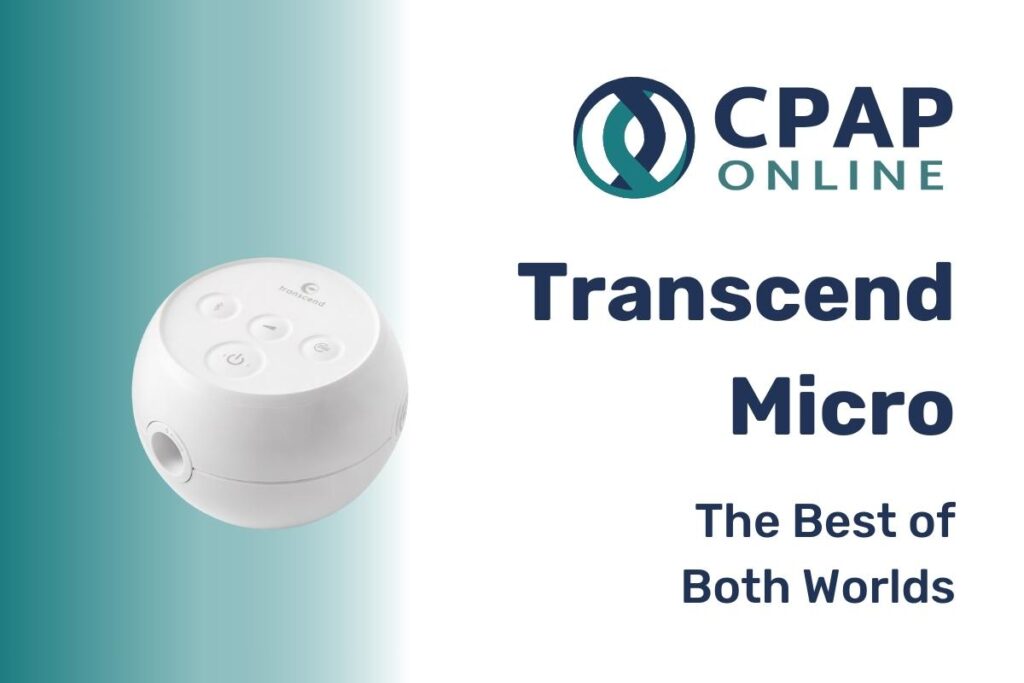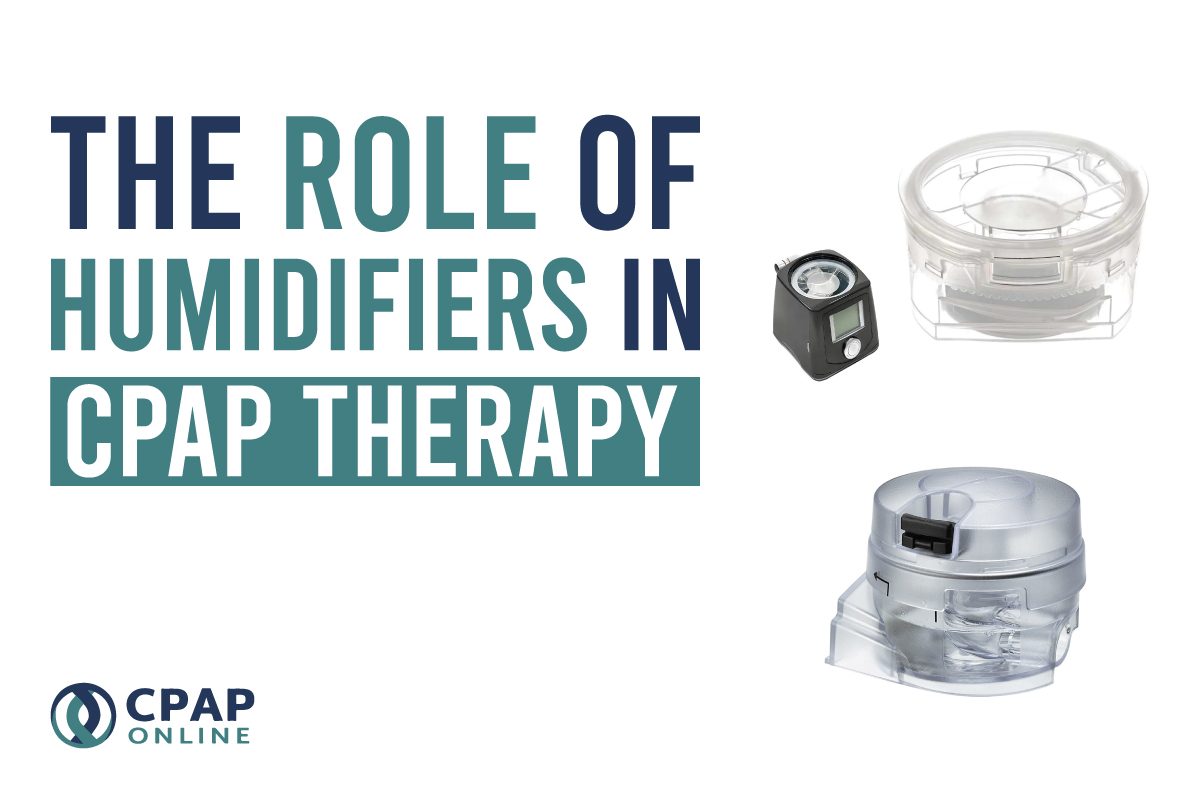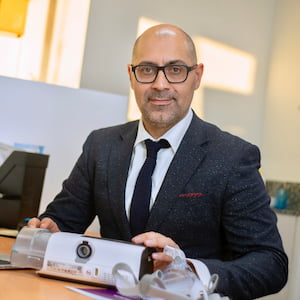CPAP devices provide room air at a higher pressure to assist your airway to stay open, allowing you to breathe normally while you sleep. Due to the increased pressure of air delivery through a mechanical device, the air can feel more dry than the ambient air, leading to your nose and throat experiencing dryness.
Many CPAP users report that they are experiencing discomfort due to dry air. This could lead to issues like nasal congestion, dry throat, and irritation. Having a well lubricated airway is important in CPAP therapy, it can mean that your device doesn’t have to deliver quite as much air to hold your airway open-a dry airway can be more resistive and sticky, making it harder to hold open.
This is where a humidifier plays a crucial role. By adding moisture to the air, CPAP humidifiers enhance comfort, improve therapy deliverance and adherence to use, all while preventing common side effects.
In this blog, we explore the history of humidifiers in CPAP therapy, whether you truly need one, and waterless humidification.
The History of Humidification in CPAP Machines
The integration of humidification into CPAP therapy was pioneered by Fisher & Paykel Healthcare. In the late 1960s1, they developed the first heated humidifier for use with patients undergoing mechanical ventilation in intensive care units. This innovation laid the foundation for incorporating humidification into CPAP devices. Building upon this foundation, Fisher & Paykel introduced heated humidification into CPAP therapy in the early 1990s2. Leveraging their expertise in intensive care ventilation, they recognised the importance of delivering air at appropriate humidity levels to enhance patient comfort and compliance.
How a CPAP Humidifier Helps
Your nose, throat and respiratory system are lined with a mucous membrane which secretes mucus to line and protect the area. A CPAP humidifier works by introducing moisture into the airflow, preventing dryness in the nasal passages, mouth, throat and upper airway. Here are the key benefits:
- Enhanced Comfort: Moist air prevents the drying out of mucous membranes, reducing irritation in the nasal passages and throat.
- Improved airway compliance: A moistened airway is less resistive, and therapeutic pressure needs can be lower with the use of humidification.
- Improved usage compliance: Users are more likely to adhere to CPAP therapy when it is comfortable, leading to better treatment outcomes.
- Prevention of Nasal Symptoms: Humidification helps reduce nasal congestion, dryness, and nosebleeds, which are common issues among CPAP users.
The Role of Heated Tubing in CPAP Therapy
Heated tubing works in conjunction with a CPAP humidifier to maintain air temperature as it travels through the tube. This prevents condensation build up, where the water vapour becomes heavy and pools in your CPAP mask or it may end up running back down into your machine making a gurgling sound, this phenomenon is known as “rainout”.
Rainout occurs when warm, moist air cools creating pools of water within the tubing. Some users find that heated tubing alone reduces dryness, making a humidifier unnecessary. However, for optimal comfort, using both a device specific heated tube and a humidifier, ensures consistent warmth and humidity levels with some devices.
Do You Need a Humidifier
No, but—here’s something important to keep in mind! While CPAP machines can run without a humidifier or water in the chamber, many users find that adding humidification makes a big difference in comfort.
Factors to consider include:
- Climate: Dry or extreme cold environments can make a humidifier more beneficial, you may also need a humidifier or heated tube in some months of the year, depending on location and climate.
- Personal Comfort: If you experience nasal congestion, dry mouth, or discomfort, a humidifier can help alleviate these symptoms.
- Health Conditions: Individuals prone to sinus infections or nasal dryness may benefit more from humidification.
- Brand of device being used: Do the manufactures promote use of humidification/ heated tubes with their device and sell these items together as a standard? Some brands like Lowenstein who use advanced event detection to ensure optimal therapy pressures remain as low as possible, avoid the need for humidifiers or heated tubes in most cases- even adding their humidifier to the device can increase moisture levels without water being put in the chamber due to the shape and design of the chamber. F&P CPAP devices are built around their humidification system.
- Physician instruction: If a physician has advised or specifically instructed you not to use humidification, then do not use a humidifier, if unsure as to why and you have been advised this by a physician and are experiencing dryness and discomfort, please discuss with them to see if they have a suitable solution in mind.
It’s essential to assess your personal comfort and circumstance, consult a healthcare provider to determine the best CPAP setup for your needs.
Is a Humidifier Needed for Full-Time CPAP Users?
For those who rely on CPAP therapy every night, a humidifier can be an essential component of their setup. Long-term CPAP use without proper humidification may lead to chronic nasal dryness, throat irritation, and even an increased risk of sinus infections. Full-time users often benefit from:
- Consistent Comfort: Using a humidifier every night can ensure that airways remain moisturised and irritation-free.
- Better Sleep Quality: Avoiding dry mouth and congestion improves sleep continuity and reduces nighttime disruptions.
- Prevention of Long-Term Side Effects: Regular exposure to dry pressurised air could lead to inflammation and discomfort, making humidification crucial for sustained CPAP therapy adherence.
If you use CPAP therapy nightly, investing in a humidifier that is complimentary to your device, can significantly improve your experience and long-term comfort.
However, water-based humidification might not always be the most convenient option while travelling.
Enter Waterless Humidification
If you’re confused about what this means, we got you! Waterless humidification is an alternative to traditional CPAP humidifiers that provides moisture without the need for water or electricity. Instead of using a heated water chamber, waterless humidification relies on Heat Moisture Exchanger (HME) technology, which captures moisture from the user’s exhaled breath and reintroduces it into the airflow.
The Benefit? No need to carry distilled water when travelling! However, while effective, HME-based humidification is not as powerful as traditional heated humidifiers, and moisture levels may vary based on the user’s breath and environmental conditions.
Something important to note: HME units must be replaced every 30 days to maintain effectiveness and hygiene.
While waterless humidification offers convenience and portability, not all CPAP machines support it the same way. If you’re a frequent traveller, choosing the right CPAP device with effective waterless humidification is key to maintaining comfort on the go.
Travel Smart: CPAP Travel Machines With Waterless Humidification
While waterless humidification is an excellent alternative to traditional humidifiers, not all CPAP machines support it in the same way. Let’s take a look at how different travel CPAP devices integrate waterless humidification and which ones offer the most flexibility.
ResMed AirMini: The first to introduce waterless humidification—with a catch
While Transcend was the first CPAP3 to use waterless humidification through Heat Moisture Exchange (HME) technology, ResMed later popularised the concept with its HumidX4 system, bringing it into the mainstream CPAP market. This innovation allows users to experience humidity without needing a traditional water chamber.
However, it also broke the unspoken rule of CPAP mask compatibility—unlike standard CPAP machines that work with most masks, the AirMini only supports specific ResMed masks.
P.S. If you missed our detailed guide on CPAP mask compatibility, you might want to check it out for more insights.
BMC travel CPAP: Flexible mask choices, restricted humidification
The BMC Travel CPAP improves on the AirMini by offering a standard hose design, allowing users to pair it with any CPAP mask. However, waterless humidification is only available when using a compatible BMC mask, limiting options for those who want the convenience of waterless humidification with their preferred mask.

Then comes the Transcend Micro Travel CPAP which eliminates these restrictions by offering true mask compatibility while still supporting waterless humidification through HME filters. Unlike the AirMini and BMC Travel CPAP, the Transcend Micro allows users to choose any mask without sacrificing humidification benefits, making it the most versatile option for frequent travellers
With new travel CPAP options like the Transcend Micro, users no longer have to compromise between mask flexibility and humidification—they can have both, making it one of the most practical choices for those on the go. While travel CPAP options like the Transcend Micro offer convenience, travelling with a CPAP machine still comes with unique challenges—especially when it comes to humidification.
Using a CPAP Humidifier While Travelling
While travel CPAP machines offer convenience, managing humidification on the go requires some extra consideration. Here are a few key factors to keep in mind.
- Short-Term Travel: If you’re travelling for just a few days, you can use a side cover and a heat moisture exchanger (HME). This portable option captures exhaled moisture and provides some humidification, though not as effectively as a water-based humidifier. They also need to be replaced frequently, as they rely on expired air for moisture.
- Battery Life Considerations: If you rely on a portable CPAP battery, using a humidifier can drain power quickly. A CPAP machine with a humidifier may last only 2-3 hours on battery, while without it, the battery could last 7-16 hours, depending on the pressure settings and battery used. Most manufacturers recommend turning off/removing the humidifier when using battery power.
- Optimal Travel Solution: If you’re a frequent traveller, choosing a CPAP machine with the right humidification setup is key. Some travel CPAP machine integrate waterless humidification, while others require external humidifiers—so selecting one that aligns with your needs can make a big difference in comfort while on the go.
- You may wish to add a humidifier : If you don’t normally need a humidifier and are from an area that is tropical, or has high levels of relative humidity, and are traveling to somewhere that is extremely cold or dry, you may wish to purchase one to take with you.
Final Thoughts
A CPAP humidifier isn’t a necessity, but for many users, it makes therapy much more comfortable. If you experience dryness, nasal congestion, or irritation, humidification could be the key to better sleep and long-term therapy adherence. If you’re unsure, test your therapy without it for a few nights—your comfort will be the best guide. For travellers, a heat moisture exchanger (HME) or a travel CPAP with waterless humidification can be a great alternative.

